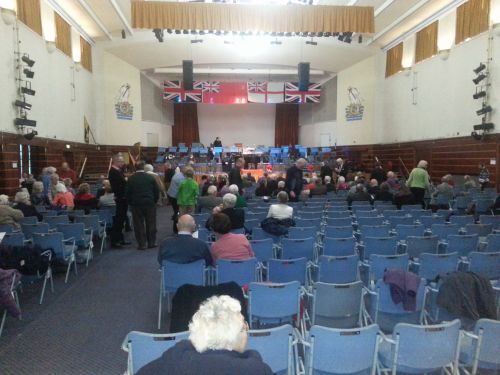 United Kingdom Lloyd, R Strauss, Shostakovich: Anna Gorbachyova (soprano), Worthing Philharmonic Orchestra / John Gibbons (conductor), Assembly Hall, Worthing, 10.11.2013. (RB)
United Kingdom Lloyd, R Strauss, Shostakovich: Anna Gorbachyova (soprano), Worthing Philharmonic Orchestra / John Gibbons (conductor), Assembly Hall, Worthing, 10.11.2013. (RB)

George Lloyd Symphony No. 6 (23′)
Richard Strauss Four Last Songs (24′)
Shostakovich Symphony No. 5 (44′)
On Remembrance Sunday Worthing was bathed in dazzling Winter sunshine. Title and content of this Assembly Hall concert coincided. The programme grouped music by British, German and Russian composers and the solo singer of the Strauss songs was Russian – a touch that, wittingly or not, echoed Britten’s use of German, Russian and English singers at the premiere of his War Requiem. The above-stage area continued the theme with the flags of these three Allies in a line across the proscenium. There was no German flag, but the USA was not present either. Groups of large poppies were placed along the audience-facing lip of the three-tier stage.
The George Lloyd Symphony, rather like his Fourth, found reactive inspiration in the composer’s horrific time as a Royal Marine on the Murmansk Arctic Convoy route in the Second World War. The Strauss Four Last Songs date from the year of the composer’s death in the wake of the same war. Their glowing romantic escapism from the spirit of the times contrasts with the composer’s embrace with tragedy in Metamorphosen. The Shostakovich symphony – his most popular – also had a character rooted in conflict and vainglory from a USSR whose deaths and devastation during that war were huge. It dates from five years before the German invasion of Russia in 1941 and was first performed the year before that event.
The Lloyd symphony is short – about 24 minutes over three movements. It is a delightful work, combining Tchaikovskian drama, dancing exuberance and surprisingly little obvious torment. If you want Lloyd with a little more angst then try his numbers 5 and 7. It would in fact have made an even better concert-closer to send the audience home with a skip in its step and a quickened pulse. However placing an unfamiliar symphony last in a programme is a hostage to early audience departure so it was a shrewd move to have it first.
Of Lloyd’s twelve symphonies this is the finest. It is concise – the perfect balance of material and time. Its Haydn-like symphonic brevity accommodates crackling Waltonian rhythmic impulse, great sweeping tunes, balletic spirit comparable with that in the Fourth Symphony, sheer excitement and swooning massed violin melodies. While I wished for a larger and more weighty violin section in an orchestra already sixty strong, the performance was highly accomplished with John Gibbons drawing out the work’s delicacy, romance and delight – of which there is plenty. That lightness of heart and transparency can be compared with the operatic blaze we heard from the early 1980s concert performances from Edward Downes when the work was first heard. It’s a glorious work heard either way with stratospheric breath-defying work by principal flute in the finale and romantic aplomb from the principal clarinet in the second movement. We should be hearing this in concert programmes again and again.
The Strauss Songs are clearly a favourite with John Gibbons. Their fine misty emotionalism came across faithfully in the playing and in singing of Anna Gorbachyova. Helpfully the programme – itself an example of how to present such a thing – printed the sung words and translations. The conductor, who spoke about each work from the podium, placed September after Beim schlafengehen, making a more successfully contoured sequence than that in the score. The ordering in the score is, as Mr Gibbons reminded us, not the composer’s choice but that of the publisher. Ms Gorbachyova was heartfelt in her delivery. I needed the booklet all the time to follow the words – not that unusual. The approach was very much that this strong creamy voice was another, though principal, line that rose and fell within the orchestral tissue: sometimes assertive, sometimes subsumed.
During the interval we had time to look at the exhibition about Lloyd, HMS Trinidad (Lloyd’s ship; his orchestral march of that name was premiered at the 2013 Last Night of the Proms) and the Arctic convoys. The concert was also attended by veterans of that campaign and by one of the local MPs who had been associated with the only recently successful efforts to create and award the Arctic Star medal. The long neglect of the people who made those murderous supply voyages and the wrongly forgotten music of George Lloyd parallel each other.
The Shostakovich 5 is the composer’s most popular symphony. In announcing the symphony the conductor spoke of European and Russian approaches to its interpretation. What we heard was very much Russian in spirit: more Kondrashin than Haitink, say. The work’s sardonic humour, its romantic ice and steel and its primary colours bombast were superbly done. That desolating and shivering iciness of the third movement left a distinct chill. All of this was notwithstanding the ad lib contributions of the local seagulls during the quieter moments. Textures were wonderfully well judged and put across. Highlights included the pecked-out trumpet and drum section and trembling celesta notes in the first movement. The second impressed with its steely pizzicato and tense grotesquerie. In the strings-dominated third movement the Tapiola moments registered strongly as did the lovely duet between flute and harp – time stood still. The brass rasped and roared gloriously throughout. All in all, this was extremely good and pleased an enthusiastic audience that amounted to about 75% of the hall’s capacity.
Rob Barnett